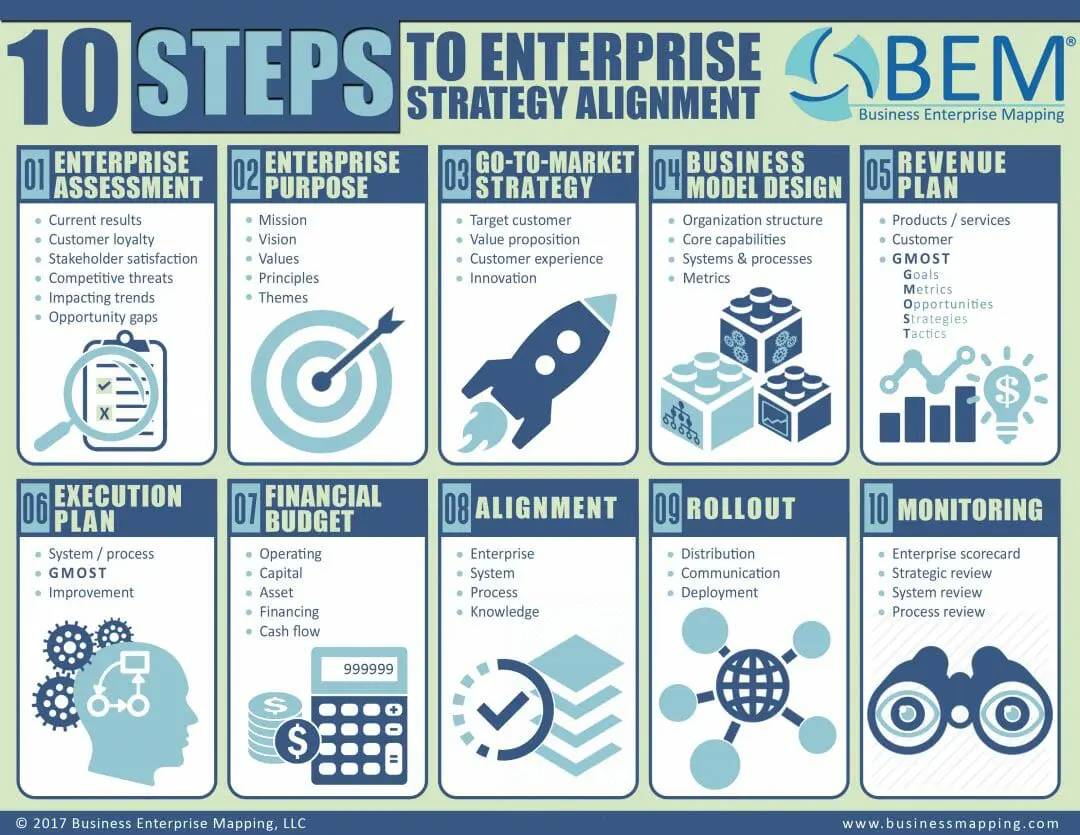Developing a successful enterprise strategy comes through a series of choices that leadership makes to deliver the overall enterprise purpose and satisfy a group of enterprise constituents, including customers, business partners, employees, shareholders and the community along the way. In the ten steps below we offer a systematic way to align enterprise strategy with systematic execution to drive sustainable performance improvement.

1. Enterprise Assessment
Enterprise Assessment evaluates several components of the organization, including current results, customer loyalty, stakeholder satisfaction, competition, trends impacting the business, and, ultimately, the most relevant opportunity gaps.
2. Enterprise Purpose
Enterprise Purpose develops the traditional mission, vision, values, and operating principles, which include the primary themes or focus of the business.
3. Go-to-Market Strategy
The Go-To-Market Strategy defines the primary target customer and the value proposition of the enterprise in serving that target customer. In addition, it should also include an intentional design of the customer experience.
4. Business Model Design
The Business Model Design articulates how the organization will fulfill its value proposition. Identifies how Enterprise core capabilities, business systems, and processes will the deployed, along with how the organization will measure success.
5. Revenue Plan
The annual Revenue Plan includes customer, products, services, volumes, and pricing for typically 12 to 24 months going forward. It is the organization’s plan to execute its Go-To-Market Strategy. The revenue plan drives all other planning and typically requires several iterations to get right.
6. Execution Plan
The Execution Plan is the operating plan that makes the revenue plan achievable. It is the organization’s plan to execute it's Business Model Design.
7. Financial Plan
The Financial Plan is the budgeting process that brings together the Go-To-Market Strategy, Business Model Design, Revenue Plan, and Execution Plan to deliver the resulting financial impact of management intentions.
8. Alignment
Alignment is the iteration and integration of all components of the planning process. It combines Revenue, Execution, and Financial plans to align all parties on the same page.
9. Rollout
Rollout is the communication, distribution, and deployment of the Enterprise Strategy.
10. Monitoring
Monitoring is the measurement of strategy progress and the regular of performance. It typically occurs on a monthly basis with quarterly adjustments.
Enterprise Strategy for Execution Alignment
Enterprise strategy does not have to be complicated, but we know it is not easy. Many organizations grow up through a series of choices that stack up over time. Alternatively, successful leaders systematically align strategy and execution to drive improving organization performance.

